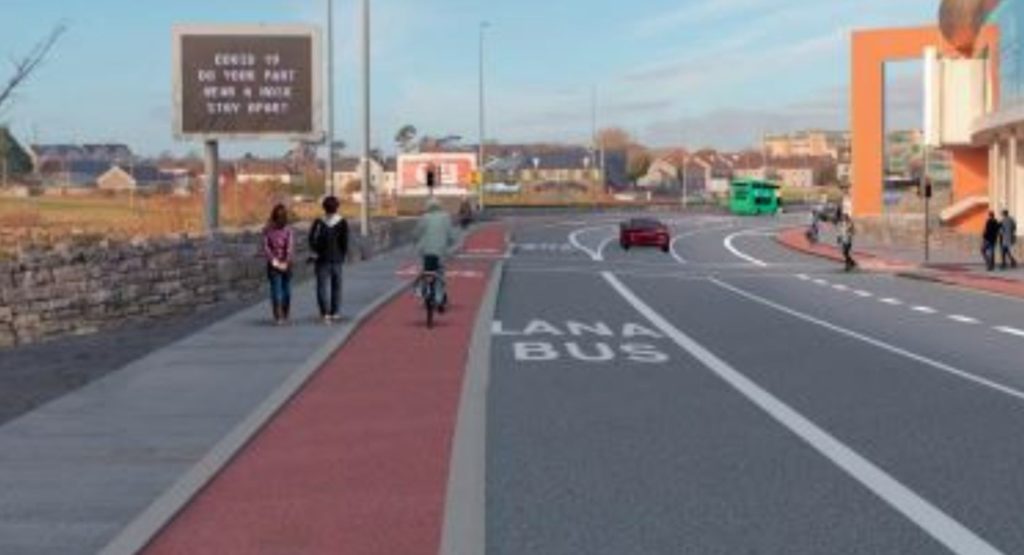A High Court challenge is being taken against a major public transport corridor in the city.
The Cross-City Link is a dedicated 4km corridor that would run the entire way from College Road towards UHG in Newcastle.
It would offer more bus lanes, cycle lanes and pedestrian facilities – and it was recently approved by An Bord Pleanala.
Papers have been filed at the High Court by active travel advocate Shane Foran, seeking leave for a judicial review of the approval of the project.
He says the case centres on traffic impacts and alleged shortfalls in the proposed road designs, as well as negative impact on cyclists using the proposed corridor.
It’s claimed that at many points, road space is being redesigned in such a way that cyclists and buses would block each other.
Mr. Foran further claims that plans to divert traffic from the central corridor at peak times will push it onto roads already well below standard for cyclists.
But, he argues, no mitigation whatsoever has been proposed by either Galway City Council or the National Transport Authority.
It’s also alleged that the Transport Minister made a Design Manual for Urban Roads and Streets mandatory, despite the material apparently being decades out of date and hostile to cyclists.
Mr. Foran’s arguments are complex and too numerous to mention in full – but a more detailed brief can be found below.
Basis of High Court Challenge Against BusConnects Cross-City Link Project recently approved by ABP
Papers have been filed at the High Court seeking leave for a judicial review of the An Bord Pleanála approval of the Galway BusConnects Cross City link University Road to Dublin Road Scheme. Shane Foran, an active travel advocate, is taking the case which also involves a challenge to the Minister for Transport over disputed road design guidance and the state’s Sustainable Mobility Policy. The scheme was approved in September and involves numerous changes to roads around the centre of Galway.
The case centres on traffic impacts and alleged deficiencies in the proposed road designs and on alleged negative impacts for cyclists using the Bus Connects corridor through the city. Various city centre roads are proposed to have footpath widening leaving narrower traffic lanes. The implication being that road space is being removed in a way that will cause cyclists and buses to block each other. In his submissions to the scheme and to the high court Mr. Foran has pointed out that there are various locations where there is apparently adequate width to have footpaths of the required standard (2m) and also traffic lanes wide enough for buses and cyclists or even cycling lanes. The design width of a standard bus is 2.6m. On University Road, cyclists and buses are theoretically to be expected to share lanes that are 3m wide with a bus expected every 2 minutes. No cycle facilities are proposed serving the university. The BusConnects traffic forecasts show that the number of motor vehicles using University road was expected to break the threshold for providing cycling facilities at the time it was planned.
In proposing the BusConnects designs Galway City Council and the National Transport Authority relied on the Design Manual for Urban Roads and Streets a document that has been made mandatory by the Minister for Transport. Mr. Foran alleges that this design manual is innately hostile to cycling in elements of its advice and is decades years out of date with regards to its content on traffic calming and appropriate road widths for roads shared between motor traffic and cyclists. Mr. Foran alleges that the conduct of the Minister for Transport in making this design manual mandatory is in direct conflict with the requirements of the Climate Change Act and associated Climate Action Plans. In 2021 the Minister for Environment, Climate and Communications strengthened the Climate Action and Low Carbon Development (Amendment) Act. Under the associated climate action plans government agencies are committed to promoting active travel. The Minister for Transport is alleged to be in conflict with this requirement to promote active travel in elements of his conduct, including elements of the 2022 Sustainable Mobility Policy.
Under the BusConnects proposals a central corridor of the city is to be closed to general traffic at peak hours using a system of timed bus gates and bus lanes. This general traffic is to be diverted to various other roads used by cyclists including various roads serving the university and university hospital. No mitigation is proposed by city council or the NTA for the adverse impact of the increased traffic. Many roads that are to receive the diverted traffic already exceed the traffic threshold for separate cycling facilities or will be pushed over that threshold by the traffic increases. Affected roads include Bothar Le Cheile, Circular Road, Bushypark, Sandy Road, Wolfe Tone Bridge, Seamus Quirke Road, Lower Newcastle Road, Newcastle Road, Shantalla Road, Siobhan McKenna Road, Upper Newcastle Road, St Mary’s Road, Bothar Na Long, Dock Road, New Dock Street, Fairgreen Road, Bothar Ui hEithir, Lough Atalia and Merchants Road.
Lough Atalia, Bothar Na Long and Dock Road have been designated by the council as part of Eurovelo 1 an international cycling route where it passes through the city. Under Bus Connects Cross-City Link, traffic volumes using Lough Atalia Road are to increase by 68% in the AM peak (944 vehicle increase) and 120% (1,111 vehicle increase) in the PM peak. Forecast traffic volumes (2,328 vehicles/hour at AM peak and 2,043 vehicles / hour at PM peak). In the design guidance that already applied when the BusConnects proposals were put together traffic levels are to significantly exceed the thresholds for separating motor vehicles and cyclists on 50km/h roads. No provision is proposed for cycling.
In his high court filings Mr. Foran is alleging that the planning board, Galway City Council and the NTA failed to have due regard for the human impact of the proposed traffic increases on various roads. He points out that the Environmental Impact Assessment process is also supposed to identify, and mitigate, adverse impacts on human health and populations as well as the environment.
In his filing Mr. Foran also raises concerns about proposed additional one-way streets in the city where the City Council and NTA also propose to apply the restrictions to cyclists. This is something that is in conflict with the NTAs own design guidance. There is a 45 year history of proposals for two-way cycling arrangements on one-way streets in Galway. Despite this the city council executive have never agreed to, or implemented, any two-way cycling arrangements on any street in the city. Under the BusConnects proposals there are to be new or changedThe affected roads include Daly’s Lane, St. Anthony’s Place Court Lane and Newtownsmith.











